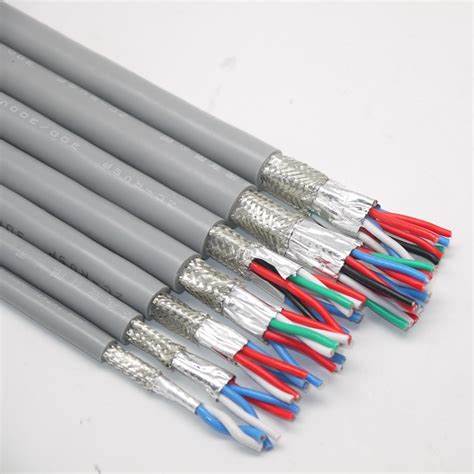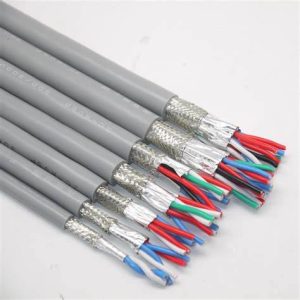

Багажны кабелийг бид ихэвчлэн хяналтын кабель гэж нэрлэдэг.
Багажны кабель нь бидний ихэвчлэн хяналтын кабель гэж нэрлэдэг зүйл юм, багаж хэрэгсэл зэрэг бусад цахилгаан тоног төхөөрөмжийн дохио дамжуулах болон удирдах шугамд тохиромжтой.


Oodedded дамжуулагч нь дамжуулагч, уян хатан байдлын уян хатан байдлыг сайжруулж чадна, хялбар утас суурилуулах.
Туузан дамжуулагчийг чичиргээтэй нөхцөл байдалд ашиглах үед, Кабелийн үйлчилгээний амьдралыг зохих ёсоор сайжруулж болно.
Каладны дамжуулагчийн хөндлөн огтлол нь ихэвчлэн дамжуулагчийн материалыг зөвшөөрдөг бөгөөд дамжуулагч дээр зөвшөөрөгдсөн хүчдэлийн бууралтыг зөвшөөрдөг.
Ерөнхий хэрэгслийн үндсэн хэрэгслийн дохиолол нь сул дохио юм, температурын өсөлт, зөвшөөрөгдөх хүчдэл буурах талаар бүү бодоорой.
Тиймээс, Крепподаны загалмай талнуудад гол зэргийн дамжуулагчийн хүч, илрүүлэх, хянах, хянагч, хянах, хянан чимэглэлийн хэлхээний тавигдах шаардлагыг хангаж чаддаг.
Зэс нь маш сайн цахилгаан шинж чанартай, бат бөх чанартай байдаг, кабелийн дамжуулагч материаллаг материалаар ихэвчлэн сонгодог.
Хүйтэн ажиллаж дууссаны дараа, нь Зэсийн дамжуулагчийн эсэргүүцэл нэмэгддэг, Хатуу байдал, хүч чадал нэмэгдэх, ба хуванцар нь буурдаг.
Хүйтэн зэсийн утсыг сайжруулах, дамжуулалтыг сайжруулах, Зэсийн хавчаарыг ихэвчлэн ашигладаг.
Зэсийн дамжуулагч дамжуулагч температурыг нэмэгдүүлэх замаар буурдаг.
Тусгаарлагчийн давхаргын гол зорилго нь кабелийн зэргэлдээх кабельеруудын тусгаарлагчийг баталгаажуулах явдал юм, мөн материалын сонголт нь орчны температур гэх мэт хүчин зүйлтэй холбоотой байдаг, Галаас хамгаалах шаардлага, Байгаль орчны шаардлага, болон холбогдох стандарт.
Химийн суулгацад, Багаж хэрэгслийн кабелийн тусгаарлагч материалууд нь польвинил хлорид зэрэг ихэвчлэн ашигладаг (PVC), полиэтилен (АСААЛТТАЙ), хөндлөн хоорондоо холбоотой полиэтилен (XLPE).
PVC нь температурын эсэргүүцлийг сайжруулахын тулд кабелийн дулааны материалд өргөн хэрэглэгддэг бөгөөд учир нь энэ нь температурын эсэргүүцлийг сайжруулах, галд тэсвэртэй, тосны эсэргүүцэл, хүчил ба Alkali зэврэлтний эсэргүүцэл, болон бусад шинж чанарууд.
Энгийн PVC-ийн тусгаарлагдсан хэрэгслийн кабель кабель кабель дамжуулах хугацаа урт хугацааны температур 70 ℃, Богино хэлхээ дулааны тогтвортой байдал нь зөвшөөрөгдсөн температур 160 ℃. Тохирох дулаан тэсвэртэй хуванцарыг нэмж оруулсны дараа, дамжуулагчийн урт хугацааны зөвшөөрөгдсөн үйл ажиллагааны температур нь хамаарна 90 ℃ ба 105 ℃.
Бага температурт, PVC-ийн тусгаарлагдсан кабель нь хатуу, хэврэг болох хандлагатай байдаг.
PVC-ийн тусгаарлагдсан кабелийг түүнээс бага температурт ашиглах ёсгүй -15 °C.
Халоген агуулгын ачаар, шатаж байх үед зузаан хорт хар утаа гаргадаг, Бага утаа ашиглах нь сэтгэл ханамжгүй байдаг, Хоргүй бус тохиолдлууд, болон тусгаарлагч давхаргыг хлор бус галын үл тоомсорлож болно (HFFR).
PVC-тай харьцуулахад, PE маш сайн цахилгаан шинж чанартай байдаг, тухайлбал Dielectic Asport ба Dielectical EXICE.
PE Chationulation нь PVC хүйтэн эсэргүүцлээс дээр, хөнгөн жинтэй, мөн PVC дулаалгын давхаргын зузаантай ижил хүчдэлийн түвшинд бага байна.
Гэсэн хэдий ч, PE Matery нь хэцүү, зөөлрүүлэх температур бага, дөлтэй холбоо барихад шатах, хайлж байх нь амархан байдаг, Байгаль орчны стресст тэсвэртэй эсэргүүцэл муу байна.
PES DECONGED CABLE-ийн халуунд тэсвэртэй ангийг голчлон хуваана 70 ℃ ба 80 ℃.
XLPE нь термопластикаас термосластик болгож байна, стресс хагарч, огтлоход илүү их эсэргүүцэлтэй байдаг, мөн үүнээс гадна илүү их зохицох чадвартай.
Xlpe нь PE-ээс илүү диэлектрик тогтмол байдаг боловч хөгшрөлт, ус, устай илүү сайн эсэргүүцэлтэй байдаг.
XLPE-ийн дамжуулагч кабелийн кабелийн кабелийн дамжуулагчийн температур XLPE нь 90 ° C байна, болон зөвшөөрөгдсөн богино хацрын дулааны эргэлт нь 250 ° C байна. Багаж хэрэгслийн кабелийн тусгаарлагч нь PE-ээс илүү диэлектрик тогтмол байдаг.
Хэрэгслийн кабелийн дулаалгын давхаргын зузаан нь гол төлөв дамжуулагчийн хөндлөн огтлолтой холбоотой байдаг, Хүчдэлийн эсэргүүцлийн түвшин, дулаалгын материал, гэх мэт.
The тусгаарлагч давхаргын зузаан сонгосон кабелийн холбогдох стандартын заалтуудаас бага байх ёсгүй.
Тусгаарлагч нь багаж хэрэгслийн кабелийн кабелийн кабель кабелийн үндсэн тодорхойлолтоор үйлчилдэг, Ихэвчлэн араб тоонуудыг ашигладаг, болон олон тооны кабелийн өөр өөр өнгийн карбоныг ялгах эсвэл цөмийн функцийг тэмдэглэх стандарт өнгө.
Бүрээсний гол үүрэг бол кабелийг гадаад температураас хамгаалах явдал юм, даралт, Чийглэг химийн зэврэлт, болон бусад нөлөө.
Гаднах бүрээс нь галын эсэргүүцлийн талаархи кабелийн гүйцэтгэлийг тодорхойлдог чухал үзүүлэлт юм, тосны эсэргүүцэл, өндөр температурт тэсвэртэй, гулзайлгах эсэргүүцэл, шавьжийн хортон шавьжийг эсэргүүцэх, гэх мэт., кабелийн тэмдэглэгээний дүр төрхийг чухал ач холбогдолтой үйлчилгээ үзүүлдэг.
Хуягны давхарга байх үед, Дотоод бүрээс нь хуягны давхаргын металыг гадагшлуулах, боож, кабелийг гэмтээхээс сэргийлдэг.
Энэ нь кабелийн галын гүйцэтгэлийг сайжруулахад үүрэг гүйцэтгэж болно, тосны эсэргүүцэл, болон бусад шинж чанарууд.
ХӨДӨЛМӨРИЙН МАТЕРИАЛЫН СУРГАЛТ, БАЙРШИЛ, Байгаль орчны зэврэлттэй байгаль орчны шаардлага, болон бусад хүчин зүйлүүд.
Химийн суулгацад ихэвчлэн ашигладаг бүрээс бүрдсэн материалыг PVC ба HFFR-ийг агуулдаг.
Гаднах бүрээс дээр кабелийн тэмдэглэгээг голчлон товшиж бэхлэв.
Хийх ажил нь кабель нь том гаднах диаметр бүхий кабельэд тохиромжтой, болон товойлгон үйл явц нь төвөгтэй бөгөөд хялбаршлын кабелийн гаднах бүрхүүл үүсгэдэг.
Багаж хэрэгслийн кабелийн бүрээсийг ерөнхийдөө бэхээр хэвлэсэн байдаг, тодорхой лого хүрч чадна, үсгийн элэгдэлд тэсвэртэй, болон холбогдох стандарт шаардлагад нийцсэн.
Кабелийн бүрээс бүрдсэн өнгөт сонголт нь мөн кабелийн төрөлтэй холбоотой юм.
Хуягны давхарга нь ихэвчлэн кабелийн үйлчлэх, шахалтын хүчийг сайжруулахын тулд кабелийн механик шинж чанарыг сайжруулах явдал юм.
Үүний зэрэгцээ, Хуягны давхаргыг кабелийн эсрэг интернетийн эсрэг гүйцэтгэлийг сайжруулахын тулд мөн үү?.
Хуягны төрөл нь янз бүрийн хэлбэртэй байдаг, Хуяг ган утасны хуяг хэлбэртэй багаж хэрэгслийн хэрэгсэл (SWA), Ган утас сүлжих хуяг (Сэл), гантуун соронзон хальмачин (СТА) гурав.
Хуягласан кабелийн гүйцэтгэлийг хангах, Гангийн диаметр дээр багаж хэрэгслийн стандартын стандартууд, ган туузны давхаргын тоо, зузаан, өргөн, гэх мэт. Нарийвчилсан заалтуудтай байна.
Бүтцийн бүтэцтэй холбоотой ган утас эсвэл ган туузны хуяг дуулга, Хуягласан кабелийн гулзайлтын радиус нь хуягласан кабелаас том хэмжээтэй байдаг.
Кабелид гэмтэл учруулахаас зайлсхийх хэрэгтэй, кабелийг засах, тавих үед, Кабелийн радиусын радиусын радиусын кабелийн үйлдвэрлэгчийн хувьд кабелийн үйлдвэрлэгчийн шаардлагад хамрагдах шаардлагатай.
Хэрэгслийн кабелийн кабель ба цахилгаан кабель нь бодит амьдрал дахь ихэвчлэн ашиглагддаг кабель юм, Гэхдээ өөр өөр бүтээгдэхүүний шинж чанарууд нь өөр өөр хэрэглээтэй байдаг.
Багаж хэрэгслийн кабель нь 500v-ээс доош AC үнэлгээтэй хүчдэлд тохиромжтой, Ажлын урт хугацааны температур 70 ℃-ээс хэтрэхгүй байна, температур 0 ℃-ээс доошгүй байна.
Цахилгаан кабелийг цахилгаан эрчим хүчээр дамжуулж, хуваарилалт, түгээхэд ашигладаг олон төрлийн тусгаарлагч кабелийг багтаасан болно, 1-500KV ба түүнээс дээш түвшний хүчдэлийн түвшинд хамаарна.
Хотын газар доорхи цахилгаан сүлжээнд ашигладаг, цахилгаан станцууд, аж үйлдвэрийн болон олборлолтын аж ахуй, дотоод цахилгаан хангамж, голын эрэг ба далайн эрэг дээр.
Өндөр хүчдэлийн цахилгаан кабелийг ихэвчлэн өндөр тэжээлийн цахилгаан кабелийн бүтээгдэхүүнийг дамжуулж, хуваарилалтад ашигладаг.
Багаж хэрэгслийн кабель нь маш тодорхой хүчдэлийн түвшинтэй байдаггүй, ерөнхийдөө бага хүчдэл, үндсэн дамжуулагч, хамгаалалтын гүйцэтгэлийн хэсэг.
Эрчим хүчний кабелийг өндөр хүчдэлийн кабелд хуваана, дунд хүчдэлийн кабель, хүчдэл багатай кабель, Утасны диаметр нь ерөнхийдөө зузаан байдаг, харьцангуй өргөн хүрээг ашигладаг.
Химийн суулгацад, багаж хэрэгслийн кабель Сонгох, дизайн дээр, ихэвчлэн дараахь асуудлыг авч үздэг:
Төслийн гэрээ, патентын худалдаачдын шаардлагын дагуу, гэх мэт., Олон улсын стандартыг үндэслэлтэй сонгох, Газрын стандарт, болон салбарын стандартыг кабелийн үйлдвэрлэлд дагаж мөрдөх, үзлэг, ба хүлээн авах, холбогдох үндэстэнтэй зөрчилддөггүй, Төслийн дизайны шаардлагыг хангаж байх үед салбар, орон нутгийн стандартууд.
Орчны температур орно, байгаль орчны зэврэлт, цахилгаан соронзон хөндлөнгийн оролцоо, дэлбэрэлтийн зэрэглэл, хэвлий аргууд, гэх мэт., кабелийн үндсэн материал, бүрээс, шилжүүлэх, хуяг дуулга, радиус тавих, гэх мэт. нөлөөлөх болно.
Дээрх шаардлагад суурилсан, Дизайн стандартын дагуу, хүрээлэн буй орчны хэрэглээ, кабелийн тодорхой параметрийг боломжийн сонголт.
Кабелийн үйлдвэрлэлийн шаардлагыг тодорхойл, үзлэг, үйлдвэрийн шатанд тавигдах шаардлагыг шалгах.
Дээрх нь багаж хэрэгслийн кабелийн нарийвчилсан танилцуулга юм, Хэрэв та кабелийн худалдан авах сонголтын талаар асуулт байвал, ZMS кабелийн багт зөвлөж байна.
Хүмүүс эрдэс бодисыг тусгаарлагдсан кабелийг сонсох үед, many immediately think of harsh environments like…
Харилцаа холбоо, цахилгаан дамжуулах системүүд хурдан ургадаг, the demand for reliable and cost-effective…
Том хэмжээний тос, хийн төслүүдэд, Аж үйлдвэрийн кабель нь зөвхөн дагалдах хэрэгсэл биш юм—they are the "nervous…
Цахилгаан холболтын ертөнцөд, кабелийн залгуур—кабелийн чих эсвэл кабелийн терминал гэж нэрлэдэг—байна…
Цахилгааны инженерийн төсөлд зөв резинэн кабель сонгохдоо, it is critical to…
Эрхэм хүндэт түншүүд, үйлчлүүлэгчид: 1-р сарын 29-ний өдөр, 2025 Хятадын Цагаан сарын баяр – Spring…